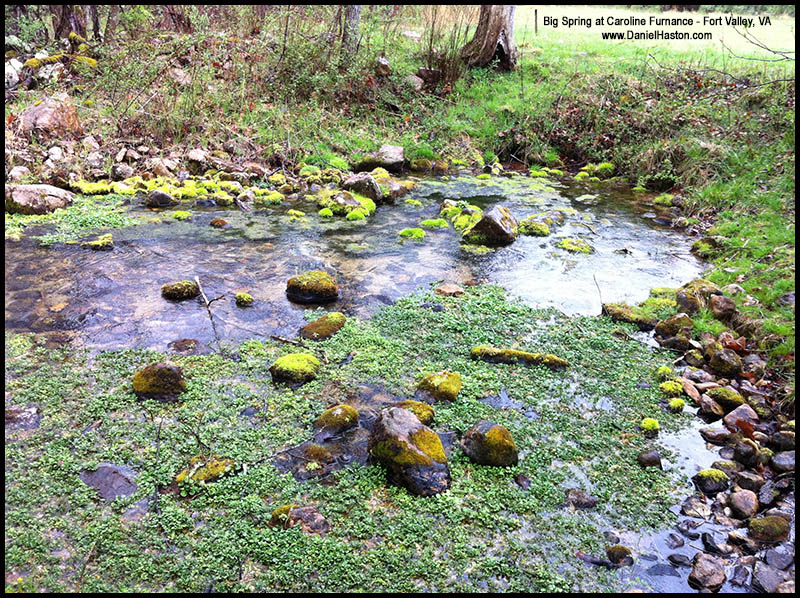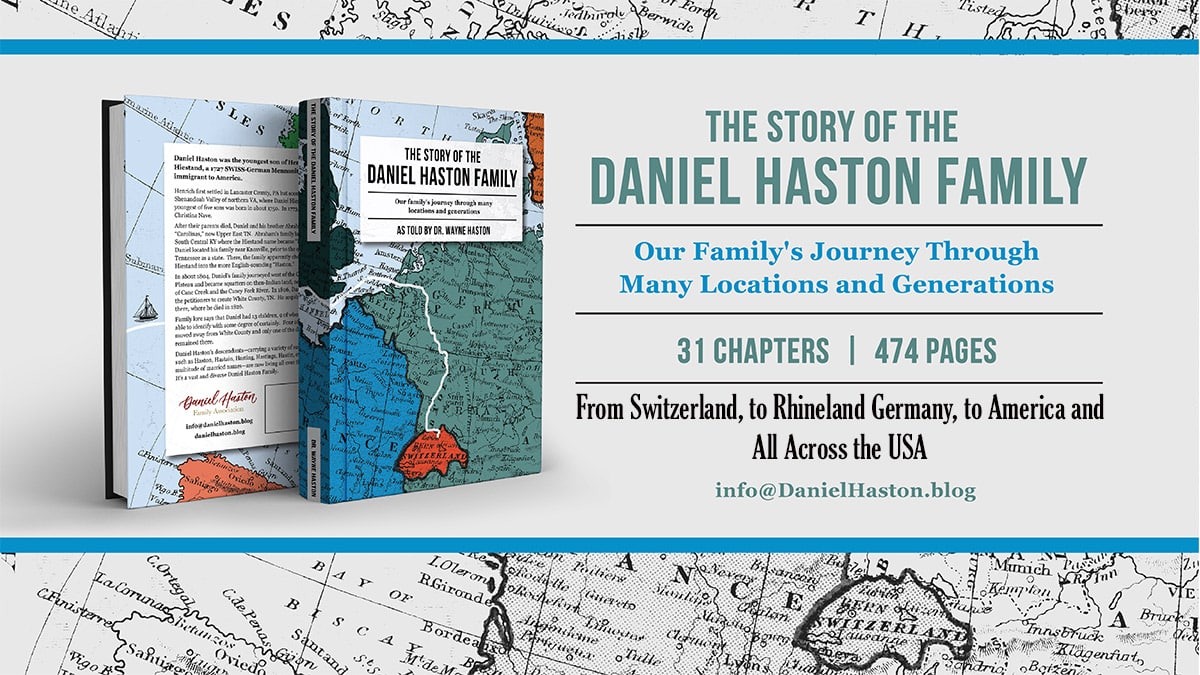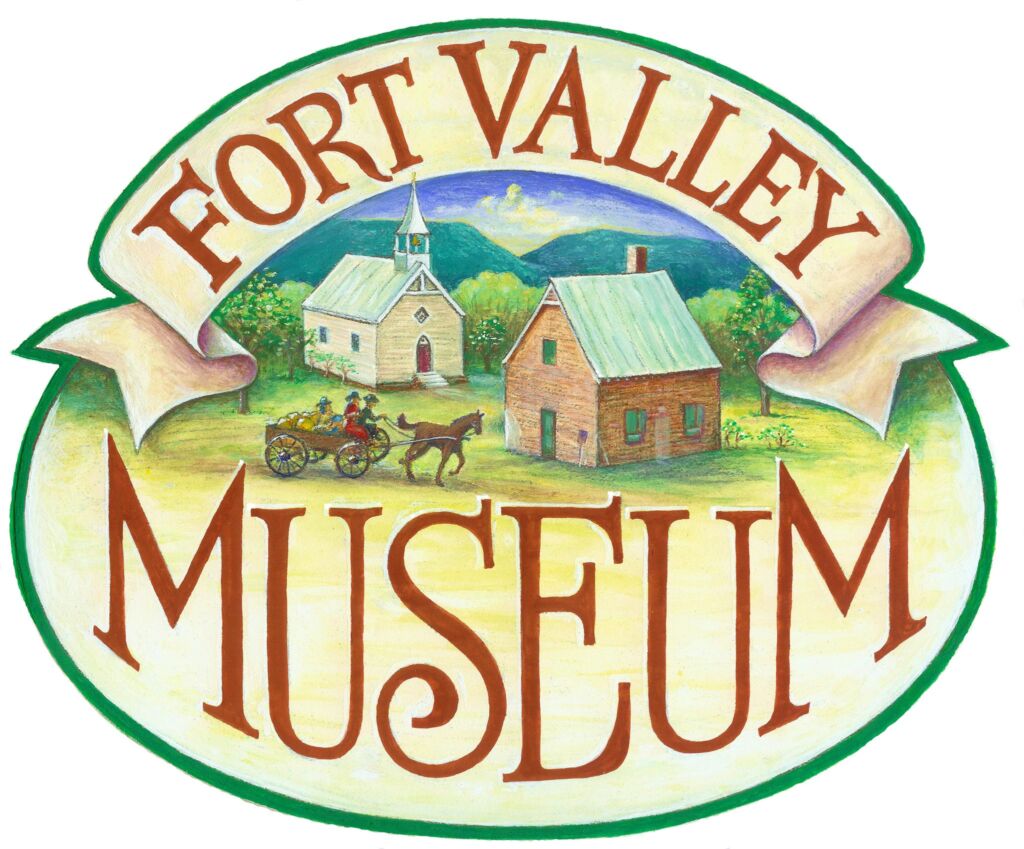14 - Daniel & Christina Nave Hiestand/Haston
Newlyweds in Fort Valley, VA

Daniel and Christina lived on Passage Creek for the first ten years or so of their marriage. Their little kids (three whose names are unknown, but David and Joseph Haston for sure) would have played in this creek at or near this very location.
Before or soon after Daniel married Christina, he lived on his father’s 400-acre tract of land in Fort Valley. Remember that beautiful place from a previous article? My guess is–from a ground level at that time–pretty much all Daniel and Christina could see was trees and brush, with a lot of different kinds of wildlife (and occasionally Indians) darting through the woods. Ladies, aren’t you glad your husbands didn’t take you to a place like that to begin life together?
On his father’s 400 acres, where do you think he built a cabin and settled? Of course, there was no pond or large cleared fields there at that time. But the Big Spring was definitely there. When Daniel brought his bride home, there was maybe enough cleared land for a little cornfield, a small garden, and a very primitive cabin.
According to the November 1775 Dunmore County, Virginia census, “Danl. Heastan” and his family were living adjacent to Daniel’s brother, Abram, in Powell’s Fort Valley. Abraham was the only male over age sixteen in his household, but there were three white males under sixteen living there and only one white female, probably his wife Magdalene (née Boehm).
Although we don’t know for sure, I’m guessing Daniel’s house was located on the southern end of Henry’s tract, near the border of his brother Abraham’s land. And I’m guessing Abraham’s house was located on the northern end of his property, very near his “Big Spring.” For protection and companionship, I’m pretty sure they lived within “hollering” distance from each other.

First Children in Daniel's Family
On a November 1775 Dunmore County, Virginia census, there were three white females living in Daniel’s household. Daniel was the only male in the family, at that time.[i] We can probably assume that one of the three white females was Daniel’s wife Christina and the other two were very young daughters.
[i] Dunmore County, Virginia Census, November 1775, Mss3 D9217 a 16-20, Dunmore County, Virginia Committee of Safety. (Richmond, VA: Virginia Historical Society).

In less than seven years after his September 28, 1773 marriage, it seems that Daniel had no fewer than four children. David Haston, the oldest known son of Daniel, was born on March 6, 1777.[i] And Daniel’s son Joseph was born on January 9, 1780.[ii] According to a land survey for Teter Clem (adjacent to Henry Hiestand’s 400 acres) of Powell’s Fort Valley, Daniel was living next “door” to Clem on May 18, 1779,[iii] so it is likely that at least four children were born to Daniel while living in the Fort in the 1770s, two daughters and two sons.
[i] Family Bible of David Haston.
[ii] Family Bible of Joe Walker (as per a September 4, 1978 letter from Dave R. Haston of Sparta, Tennessee to Howard H. Hasting of San Antonio, Texas).
[iii] Gertrude E. Gray, Virginia Northern Neck Land Grants, Volume III 1775-1800. (Baltimore: Genealogical Publishing Company, Inc., 1993), 34. Grant Book R-209.
But, then on the 1783 Shenandoah County tax list taken by Alexander Hite, Danl Heastin appears as the head of a family with seven white (and no black) inhabitants. Abm Heastin’s name is six places down the list, with eleven (white and no black) inhabitants in his household. Daniel and Abraham’s names are among others known to have lived near them in Powell’s Fort Valley.[i]
[i] Alexander Hite, “Shenandoah County, VA Census – 1783 Taxlist.” Accessed November 29, 2018, http://files.usgwarchives.net/va/shenandoah/census/1783/1783tax01.txt.
Assuming Daniel and his wife were two of his seven household members and there were two daughters born before the 1775 census, plus the births of David (March 6, 1777) and Joseph (January 9, 1780), that means that there was (apparently) one other child born to Daniel prior to the 1783 tax list. If so, ten years from the time he married Christina Nave in September 1773, at least five children in all were born and survived while Daniel’s family lived in Fort Valley. Daniel’s grandson, William Carrol Haston, said that there were thirteen children in Daniel’s family. If that is correct, there must have been eight other children of Daniel yet to be born after he moved from Shenandoah County in 1783, the same year of the Alexander Hite tax list.[i]
[i] George A. Ogle, A Memorial and Biographical Record of the Cumberland Region. (1898; reprinted, Greenville, SC: Southern Historical Press, 1995), 272.
Why Was He Living in Fort Valley?
Apparently, Daniel and Abraham’s brothers Jacob, Peter, and John Hiestand lived on portions of their father’s South Fork Shenandoah River land after they married. And we can probably assume they reared their families on the same sections they inherited when Henry died. Even though Abraham was the third oldest son of Henry, and older than John, he chose to purchase his own land and live apart from the other family members as early as 1763. Was he just more independent and entrepreneurial than the three brothers or was he not as favored by his father? We will never know. But we do know that Abraham’s family lived on the 300 acres tract he owned in Powell’s Fort Valley.
Henry’s youngest son, Daniel, appears to have been more closely associated with his ten-years-older brother Abraham than any of the other family members. At least, that’s what the existing records seem to suggest. When Daniel attained marriageable age, all four of his older brothers had already secured places to settle their families. But Henry’s 400 acres in Powell’s Fort Valley was as yet unsettled. When Henry purchased the mountain land, he probably had no intentions of anyone from the family living on it. In those days, people often bought cheap mountain land just for its timber or rail wood. But, with Abraham living adjacent to Henry’s Fort Valley tract and Daniel needing a place to settle a family, Daniel probably asked his father if he could live on and farm a suitable piece of the mountain land.
Regardless of the details as to how it came about, Daniel and his young family seem to have been living in Powell’s Fort Valley, adjacent to Abraham, in November of 1775.[i] And the “adjacent” references for Teter Clem’s warrant, survey, and deed (for 141 acres) appear to place Daniel’s place of residence on Henry’s 400 acres on October 11, 1776, January 21, 1778, and May 18, 1779.[ii]
[i] Dunmore County, Virginia Census, November 1775.
[ii] Gertrude E. Gray, Virginia Northern Neck Land Grants, Volume III 1775-1800, 34; Joyner, comp., Abstracts of Virginia’s Northern Neck Warrants & Surveys – Volume III (1710-1780). (Portsmouth, VA: printed by author, 1986), 4.
The description of Henry’s and Abraham’s Fort Valley tracts as “waste & ungranted land” in the 1700s would not surprise anyone who visits that area of the valley today. Farther down Fort Valley on Passage Creek, which meanders northward through the Hiestand properties and the entire length of the valley (thirty-eight miles total), there is some decent farming land along both sides of the creek as a result of erosion from the upper end of the valley and the surrounding mountainous walls of “the Fort.” And today there are some small open fields on the lands settled by Abraham and Daniel, probably the result of clearing efforts over the past two hundred plus years, especially related to the Caroline Furnace that was there in the 1800s and the Caroline Lutheran Camp on the same property now. But if you look around the area, you can imagine what the 700 acres of Fort Valley Hiestand land must have been like when Abraham and Daniel were raising their families there—little rocks, big rocks, thin and “often squishy” impervious soil, thick underbrush, and a mixture of virgin hardwood and pine trees.
A gazetteer of Virginia published in 1835, prior to the devastating biological, topographical and ecosystem impact of iron ore mining in Fort Valley, gives a likely-accurate perspective of what the valley would have been like when Abraham and Daniel lived there, fifty years prior to the gazetteer’s publication.
Unlike the Blue Ridge, which is extremely fertile, and the greater part of which is susceptible of successful and profitable cultivation, this [Massanutten-Fort Valley] mountain is precipitous and rugged in the extreme, and is covered, for the most part, with a thick growth of oak, pine, hickory, chesnut, &c. Its forest affords a shelter for a great number of deer, bears, turkies and other game, with which the mountain abounds. The only road [at that time] which crosses this mountain is the one which leads from Luray to Woodstock, which is at the upper end of the Ford, and which at the expense of much labor is kept passable for light loaded carriages. [Fifty years earlier, this would have been much less-of-a-road.] It is tolerably fruitful in grass, corn, rye, buck-wheat, potatoes, turnips, &c. The fort is supposed to be extremely rich in mineral ores, of which iron and copper are among its discovered mineral productions.[i]
[i] Joseph Martin, A New and Comprehensive Gazetteer of Virginia and the District of Columbia. (Charlottesville, VA: printed by the author, 1835), 44.
Referring specifically to the land that Henry and Abraham Hiestand once owned, where Daniel lived the first ten years of his married life, a former director of the Caroline Furnace Lutheran Camp which is now located on the property stated: “The soil is not suitable for farm land. It’s hard pan clay that holds the moisture.”[i] In other words, it stays “squishy” a good while after rains. This causes me to wonder, “How did Daniel and Abraham feed their families on such a wasteland?”
[i] Rebecca Marston Wilson, citing Kenn Nilson in “Joseph Vernon Marston, Sr., and Caroline Furnace” (unpublished manuscript, Autumn 1996), 7.


There is one necessity for settlers that definitely was not in short supply nor of poor quality on the Hiestand lands—crystal clear, clean water. Passage Creek itself provided an abundant and perpetual supply of water, but the “Big Spring” located near the north edge of Abraham’s property would have been an ideal place to build a cabin. It requires no stretch of imagination to assume that Abraham lived somewhere very near the Big Spring. And the spring is so near the southern edge of Henry’s 400 acres tract that Daniel may have established his home near there also, to be close to Abraham’s family for safety and companionship as well as to have access to the ever-cool spring that has a production capacity of seven hundred gallons of water per minute,[i] perhaps more in the 1700s. Not only would it have provided plenty of convenient, safe water, but constant and stable refrigeration as well. In later years, the spring was sometimes known as “Furnace Spring” and local residents would go there for water in seasons of drought and gather there for picnics in the summer.[ii]
[i] Ritenour, Trott, and Trott, 65.
[ii] Ritenour, Trott, and Trott, 435.
In addition to building a family, several other significant events occurred in the Hiestand family and the North American British colonies Daniel while he was living in Powell’s Fort Valley:
- May-October 1774 – Dunmore’s War with Shawnee and Mingo Indians, in which many Shenandoah Valley men fought.
- July 2, 1776 – The Continental Congress voted to declare independence from Great Britain on July 2, 1776. Two days later, they adopted the Declaration of Independence and the American Revolution was officially in progress.
- January 12, 1777 – Daniel’s mother “left this world for eternity.”[i]
- March 22, 1777 – Daniel’s father signed his “last will and testament.”[ii]
- March 22-25, 1777 – Daniel’s father conveyed one-third portions of his South Fork Shenandoah River land to his sons, Peter and John. Jacob would receive the other third when his father died, according to the will.[iii]
[i] “Peter Hiessandt, Sr.’s Bible,” from “Bible Records for Heiston Family of Page County, Virginia” (translated from old German script). (Luray, VA: Family file in Page Public Library).
[ii] Amelia C. Gilreath, Shenandoah County, Virginia Abstract of Wills, 1772-1850. (1980, reprinted, Westminster, MD: Heritage Books, 2007), 93; Will Book B, 2.
[iii] Gilreath, Shenandoah County, Virginia Deed Books Series, Volume 1 (Abstracted), 82.
In the next article, you will learn about Henry Hiestand’s will and the curious comment Henry made concerning his youngest son (Daniel) and youngest daughter (Magdalena).
Here’s why people want to live in Fort Valley today.
If you appreciated this article, please share it with others who might also enjoy it.


